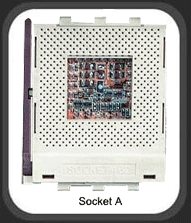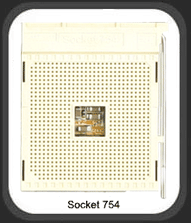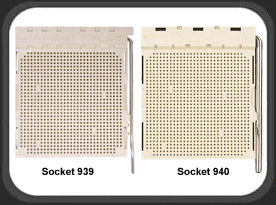This two-part series of Tech Tips started with a look at a few details of each of Intel’s modern processors (See CPU Socket Basics, Part 1), and how they are all similar and different from one to another. In the second and final part of this series, we will take a look at the CPU sockets supporting modern AMD processors.
Socket A:
Socket A was the staple format in AMD's line-up for years, carrying the brand through the Athlon, Thunderbird, Duron, Athlon XP, Athlon MP, and Sempron classes of processors. The number of pins found on the bottom of a Socket A CPU totals 462, and this is one of the few formats that is not named for the number of pins found on the processor.

Socket A processors came with frontside bus speeds including 200 MHz (100 MHz x 2), 266 MHz (133 MHz x 2), 333 MHz (166 MHz x 2), and 400 MHz (200 MHz x 2). Socket A processors ranged in top speeds from under 1 GHz to just over 2 GHz, but the identification of a Socket A processor's true speed is difficult due to AMD's use of PR (Performance Rating) grades instead of true processor speed as a sales tool.
For example, an AMD Athlon XP 3000+ doesn't have a speed of 3.0 GHz, but rather 2.167 GHz. AMD contends that their architecture provides performance equivalent to the PR grade, despite the actual speed being much lower.
Early Socket A systems supported SDRAM memory, but as the technology advanced and DDR memory became available, these processors took advantage of the increased performance. DDR memory offered greater overall performance at the same clock speeds as SDRAM, as well as the potential for much higher clock speeds, so it was only a matter of time before it became the standard memory for use with these processors.
Just like Intel, AMD cores in this series also have names to distinguish different levels of performance within the same class of processor. For example, Duron cores carry names such as Morgan and Applebred, while Athlon XP processor cores have names such as Palomino, Thoroughbred, and Barton (listed in order from weakest to strongest).
The long-lived success of Socket A is winding down, as the last date for orders to be placed for production has just passed. As we say goodbye to Socket A, AMD intends to focus more attention on similar processors for Socket 754, as well as the higher-end Socket 939/940 formats.
Socket 754:
Socket 754 picks up where Socket A left off, offering support for CPUs including the Sempron and Athlon 64. As the name implies, the processor features 754 tiny pins that interface with the socket on the motherboard. As processors develop, the number of pins manufacturers can fit on the back becomes more and more amazing.

The Sempron class of processor is more of a budget-conscious offering, with current PR grades available from 2600+ to 3300+, while the Athlon 64 is the more powerful 64-bit offering with PR grades from 2800+ and climbing past 3700+. All Socket 754 processors support a frontside bus of 400 MHz (200 MHz x 2), and presently all systems utilize DDR memory.
Socket 939/940:
Socket 939 and 940 support the current top-of-the-line offerings from AMD and, as the names imply, they are separated by one pin. Like their Socket 754 cousins, this format of AMD processors utilizes DDR memory (Socket 940 requires Registered DDR) and provides a frontside bus of 400 MHz (200 MHz x 2).

Socket 939 supports Athlon 64 processors with PR grades currently up to 4000+, as well as the Athlon 64 FX series which takes the performance to new levels for game play and other intensive applications. Socket 940 is more the business side of this pair of sockets, offering support for both Athlon 64 FX series CPUs and the AMD Opteron class of server processors. The Opteron series of processors include a feature called "dual-core"; where one processor is effectively seen as two, and given the possibilities of multi-processor motherboards, the computing power can be incredible. A recent release from AMD is the Athlon 64 X2, which brings high-performance dual-core technology to a Socket 939 desktop environment, but has yet to become available to the public for purchase.
Where many AMD processors used a 4 digit PR grade for marketing, the FX series of Athlon 64 processors uses a two digit code (i.e., FX-51, FX-55) and the Opteron uses a three digit code (i.e., Opteron 140, Opteron 252). The Opteron code uses a 1xx code to indicate compatibility with single processor operations, a 2xx indicates compatibility with dual processor operations, and even 8xx formats are intended for motherboards supporting 8 processors. All of these designations can sure make things confusing, and given the varied nomenclature that AMD alone currently uses, it can be tricky figuring out how fast a CPU really is.
Final Words:
As CPU technology advances, the sockets that correspond to them are forced to change as well. The new physical sizes, internal architecture, and thermal properties require that the 'packaging' evolve. A negative side effect of this development is that motherboards wind up with limited 'upgrade paths' when it comes to adding a faster processor. Although this can occasionally be remedied with socket adaptors, as AMD and Intel continue down their parallel paths of development, this situation can be expected to continue. With that said, it looks like AMD's next CPU socket isn't that far off.
Please drop by the Bigbruin.com Forum and feel free to discuss this article.
Page 1 | Home | Forum | Review Index | Page Views:
Get Tech Tips and Computer Tips at Geeks.com!
|
|